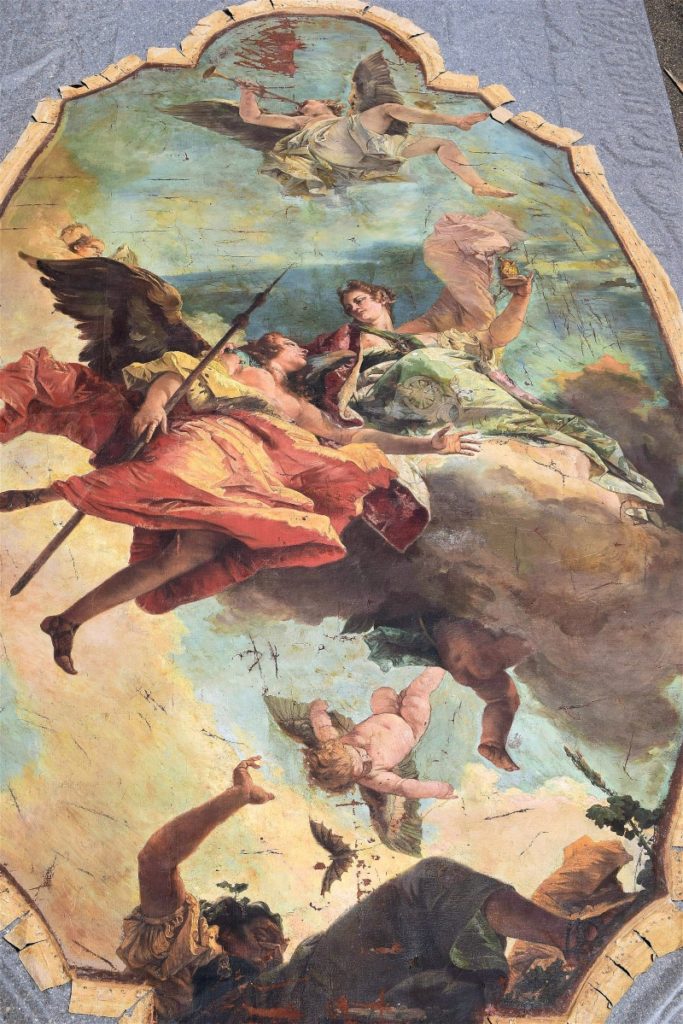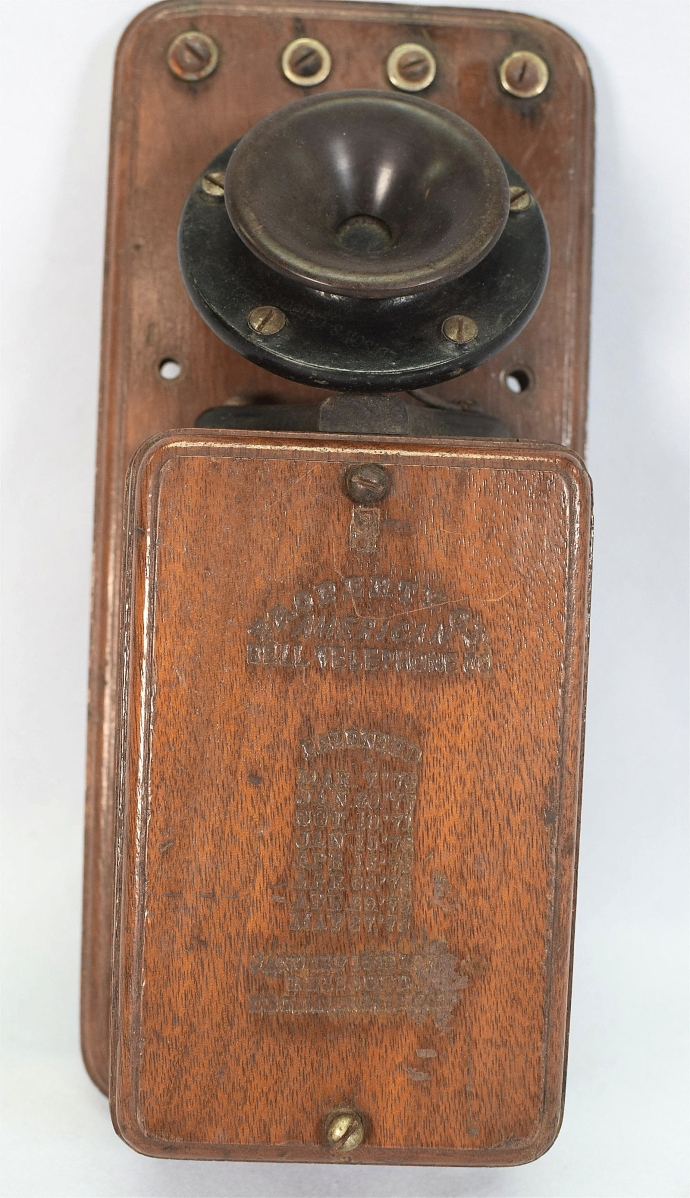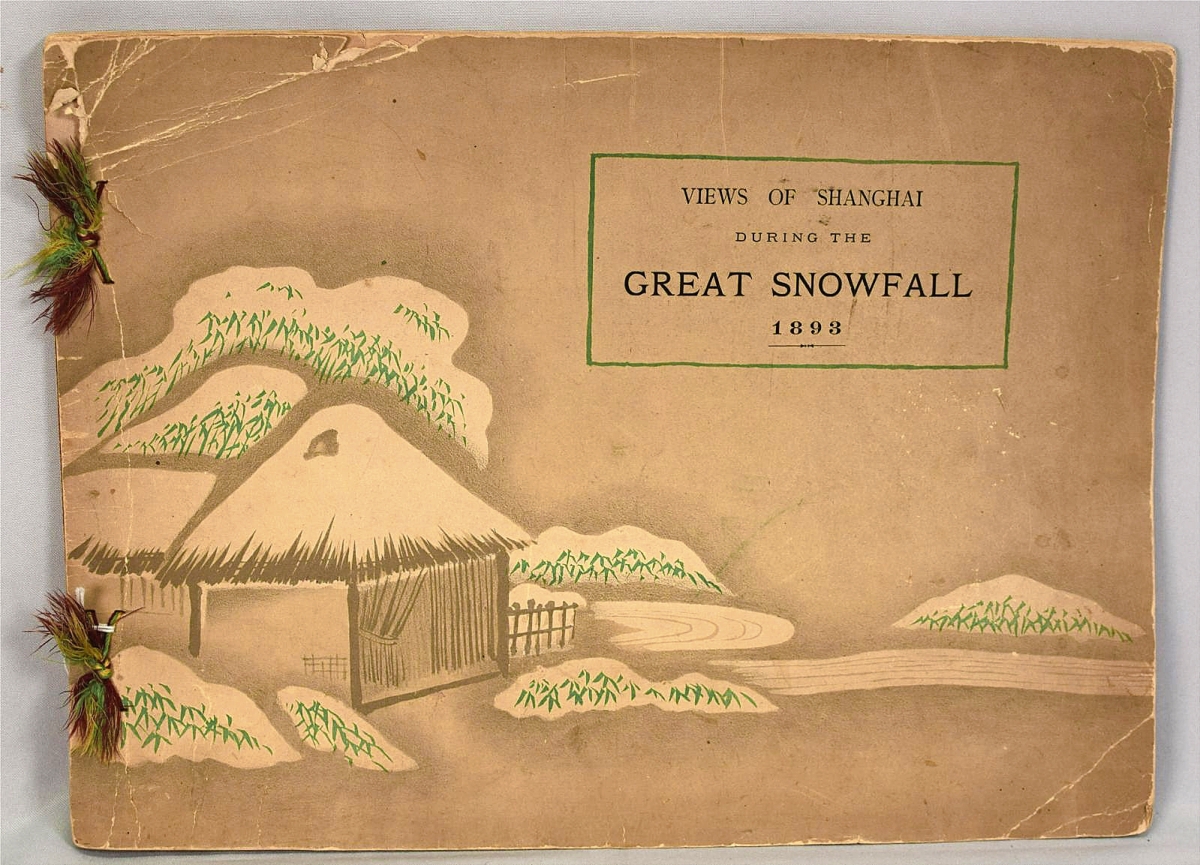
The star of the sale was this 15-by-8-foot ceiling painting attributed to Giovanni Giambattista Tiepolo. It was believed to have been made for a palace in Italy and was accompanied by numerous documents establishing its history and authenticity. Titled “Virtue, Nobility, Ignorance & Fame,” it sold for $128,100.
Review & Onsite Photos By Rick Russack, Additional Photos Courtesy White’s Auctions
MIDDLEBORO, MASS. – Kathryn Black and John White seemingly could do no wrong at their April 16 sale. They sold an Eighteenth Century Tiepolo ceiling painting for $128,100 and a small collection of early telephones for more than $100,000. They sold a diamond and gold ring for more than $10,000, a large coin collection did well and other paintings did so too. White’s slogan is “As Simple As Black & White” and it was. The salesroom was full, internet bidding was active, as were bidders on the phone, and absentee bids were processed. Buyers in the room were particularly active. The $612,000 gross was White’s best ever.
The Giovanni Giambattista Tiepolo (1696-1770) painting had come from a home in the Middleboro area, and was sold to a phone bidder, with an underbidder in the room. That phone bidder was a local collector who will install the painting in his home. White’s did its job well; the painting was heavily promoted, and the documentation authenticating the painting was available to anyone interested. The unframed painting, 15 feet long and 8 feet wide, was accompanied by a large, custom-made roller for its safe storage and transport. Its authenticity was established by extensive research done in the 1990s and earlier in this century. A large file box with the reports of the experts who authenticated it accompanied the painting. Those reports included a major stamp of approval by Professor George Knox in 1991 and the Academy of Science, in Udine, Italy, dating to 1970-72. Knox wrote his MA thesis on Tiepolo drawings at the Victoria and Albert Museum and published extensively on Tiepolo.
Included in the file were earlier appraisals authenticating the work, a 1992 letter from Sotheby’s expressing its willingness to sell the painting, a 2005 letter from a Parisian appraiser and a letter from Dr Walter Liedtke, curator of the Metropolitan Museum of Art, on museum letterhead, confirming the expertise of the French appraiser. There was also a report of a scientific analysis by Dr Nicholas Eastaugh done in 1991. That early research established that the painting, “Virtue, Nobility, Ignorance & Fame” (Putting Ignorance to Flight), was commissioned by Count Carlo Caiselli, circa 1742-43, for a ceiling in the Palazzo Caiselli, or his villa of Percoto or his Cortello Villa in the Udine province of Venice, possibly on the occasion of one of his son’s wedding or the occasion of his other son’s appointment as noble councilor. The count’s palace, built a century earlier, was the home of a significant collection of master paintings. The residence still stands, including the room in which this ceiling painting hung. The building is now the property of the University of Udine.

The framed key is of particular importance to collectors of early telephones. It’s the key to the building in Boston in which Alexander Graham Bell had his laboratory and in which Charles Williams produced some of the Bell telephones. Along with an 1877 Blake transmitter, the lot sold for $43,920.
White’s website included YouTube videos by George Knox, specifically discussing the painting and its background. The underbidder, Raymond Young, a collector from Gloucester, Mass., said that he had hoped to buy the painting, have it conserved and installed on the ceiling of a 40-by-50-foot ballroom in his home, or possibly installed in a home he owns in Udine. “I would have to do some substantial remodeling to install it properly, and with the conservation it needed, I estimated that it would actually cost me about $250,000. So I stopped at $100,000 and the phone bidder got it for the next bid.”
The Tiepolo was not the only home-run of the day. There were six early telephones, sold in six lots, that were a surprise to the auctioneer and most of the buyers in the room. Two of the six offerings sold for $43,920 each. In 1876, Alexander Graham Bell was granted a patent for a method of transmitting speech by telegraphy – in other words – the telephone. His was not the only patent granted. Bell had a laboratory at 109 Court Street in Boston, a building also occupied by Charles Williams, a maker of electrical equipment, and Williams produced some of the earliest telephones, including what has become known as the “coffin” style of phone. There were numerous variations as experiments were conducted but the coffin-style phone is the one that many think of as the “old-fashioned” phone hanging on the wall with a crank and horn for speaking. Some had several parts – separate sections for batteries, transmitters and speakers. In some models the same horn was used for speaking and listening to the other person.
A coffin-style phone, stamped property of the American Bell Telephone Company, with several patent dates, the latest being 1879, was one the phones bringing $43,920. It had an iron and gutta percha receiver. Bringing the same price was a lot with two items – a framed iron key and a #277 Blake transmitter with an 1877 patent date. Francis Blake, another inventor, also working in Boston, developed the first successful telephone microphone to effectively transmit spoken words. Eventually, they were made by several early manufacturers. The inscription at the bottom of the framed iron key read “Key To The Birthplace of the Telephone 109 Court Street Boston As It Was In 1876.” Presumably, this was the key to the building housing Bell’s laboratory.

The sale included some exceptional Victorian silverplated bride’s baskets with glass inserts by the Mount Washington Glass Company. This one, with two glass baskets, was surmounted by a cherub holding a bird. Other cherubs were at the base, and it brought $4,575, the highest price of the selection.
Dennis Berry, a collector of early telephones, had come from Ohio specifically to bid on these phones and was successful on two. He said that he has about 200 early phones and believed that the rarity of these justified the trip. He also said, “I’m going home happy.” The early history of the telephone is complicated with several competing companies suing one another for patent violations, and new developments being frequent. The collection was consigned by the son of the collector, a long-time telephone worker, and White’s will have additional material from that collection in future sales.
The sale included several other collections and categories that drew numerous bidders. A collection of more than a dozen truly outstanding Victorian bride’s baskets was consigned by a local collector from the New Bedford area. Most of the colorful and hand-painted glass inserts had been made by the Mount Washington Glass Company, also from New Bedford. Selling for $4,575 was a large, silverplated example with putti and birds that was more than 22 inches tall. The two cased ruffled cranberry bowls, with polished pontils each had hand-painted chrysanthemums. Another, on a 16-inch Wilcox silverplated base with three winged cherubs working at a blacksmith’s forge sold for $2,160. The melon-shaped, cased glass Mount Washington bowl in opalescent pink and yellow was decorated with heavily enameled chrysanthemums. Most of the other bases were also figural and most glass inserts were hand painted.
There were more than 40 lots of coins and currency, with many of the coins in Whitman folders. White’s does not grade the coins it offers, so in-person examination was necessary. The firm has a good following for coins and many of its sales include a wide selection. Topping the offerings in this sale was a lot with 63 Morgan, or Liberty Head silver dollars, 1878-1921, which brought $3,965, and a lot with 142 silver half dollars brought $2,196. Each lot included some key dates.

A 1955 baseball autographed by Ted Williams and other members of the Boston Red Sox reached $1,037.
There were more than 15 lots of toys, several were tin windups and the most sought-after was a well-dressed couple walking arm-in-arm with a small dog by their side. Made by Lehman and, according to the catalog, representing Ernst Lehman and his wife Martha, the woman’s purse was missing, but the toy in otherwise good condition earned $2,684. Another tin wind-up, in working condition, by an unknown maker and portraying a well-dressed woman holding an umbrella and wearing glasses sold for $1,708. A 35-inch Kingsbury aerial ladder fire truck, complete with hand-cranked adjustable ladders, earned $1,830.
After the sale, Kathryn Black and John White said, “We’re pretty tired but everything went so well. It was our best sale ever, more than $612,000, so what else is there to say? We had a large, enthusiastic crowd in the room and they took home a lot of the stuff. The major items went to retail buyers, which we’re always glad to see. We’ve spoken to our consignors and everyone is happy. There’ll be more stuff from the consignor of the early telephones, we have another good coin collection coming and everyone is satisfied. We’re looking forward to the next one.”
Prices given include the buyer’s premium as stated by the auction house. For information, www.whitesauctions.com or 508-947-9281.



























